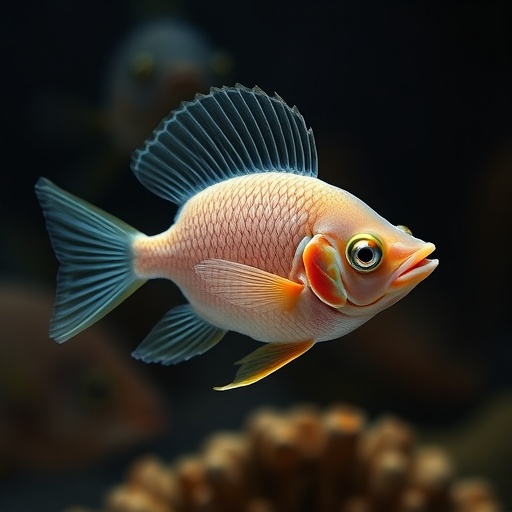
In a groundbreaking study, researchers have embarked on an intricate investigation into the biological phenomenon of juvenile hermaphroditism in the silver pomfret, scientifically known as Pampus argenteus. This distinctive trait, characterized by the presence of both male and female reproductive organs, has long fascinated biologists, particularly given the ecological and evolutionary repercussions of such reproductive strategies in aquatic species. While the silver pomfret is recognized for its importance in marine ecosystems and fisheries, the underlying mechanisms governing its sex-switching behavior remain poorly understood. The recent transcriptome analysis conducted by Li, Hu, Wang, and their colleagues sheds light on this complex biological process, potentially paving the way for future research in the field of sexual differentiation in fish.
The silver pomfret, a celebrated species in both culinary and ecological contexts, exhibits a remarkable adaptability to varying environmental conditions. Its ability to switch between sexes during various life stages enables it to optimize reproductive success in fluctuating populations and environments. The researchers aimed to uncover the molecular and genetic foundations of this sex-switching mechanism, which is not only a fascinating area of marine biology but also a critical topic in understanding the evolutionary strategies employed by species facing environmental challenges.
Through their comprehensive transcriptome analysis, Li and his team meticulously dissected the genetic expressions associated with sex differentiation in juvenile silver pomfrets. Utilizing sophisticated sequencing technologies, they were able to compile a rich dataset of gene expressions linked to reproductive development. By comparing data between individuals exhibiting male and female characteristics, the researchers identified a suite of genes that appeared to play pivotal roles in the process of sex determination and differentiation.
Among the significant findings were particular gene families that showed upregulation in individuals transitioning from juvenile to adult stages. These gene families are suspected to interact with hormonal pathways that dictate sexual development, suggesting a sophisticated interplay between genetics and hormonal signaling in mediating sex-switching behaviors. The researchers employed pathway analysis tools to understand the complex interactions between these genes, revealing potential new targets for future studies aimed at manipulating or understanding sexual development in aquatic species.
As the study progressed, the researchers noted that environmental factors, particularly temperature and salinity, could influence gene expression patterns related to sex differentiation. This finding highlights the potential impact of climate change on marine species, raising concerns about how shifting environmental conditions may disrupt established patterns of reproductive success. The implications of these findings are vast, extending beyond the silver pomfret to consider broader ecological dynamics and the survival of numerous species that depend on specific reproductive strategies.
Furthermore, the research team dedicated time to explore the evolutionary significance of hermaphroditism in silver pomfret populations. They postulated that this dual-sex capability allows for increased genetic diversity and adaptability in fluctuating environments, offering a reproductive advantage over strictly dioecious species. By leveraging the potential benefits of both male and female reproductive strategies, Pampus argenteus may be better equipped to survive and thrive in diverse marine ecosystems.
The implications of this study extend to marine conservation efforts as well. Understanding the mechanisms of sex differentiation could aid in the development of strategies to manage and protect vulnerable fish populations in the face of overfishing and habitat degradation. By recognizing how reproductive strategies are influenced by environmental factors, biologists can implement more informed conservation practices that cater to the specific needs of these species.
Moreover, the findings could prompt further investigation into the genetic basis of hermaphroditism in other fish species, encouraging a broader exploration of sex-changing mechanisms across taxonomic groups. This study may serve as a benchmark for future researchers looking to delve into the genetic underpinnings of sexual differentiation, creating a foundation of knowledge that could enhance our understanding of reproductive biology in aquatic environments.
As the field of marine biology continues to evolve, the insights gained from this research stand to inspire a new generation of studies that consider both genetic and environmental contributions to sex determination. The nuanced understanding of the unique adaptations possessed by silver pomfret will likely underscore the importance of preserving these organisms and their habitats. It is evident that the interplay between genetics, environment, and sexual strategy holds the key to unlocking the mysteries of hermaphroditism.
In conclusion, the narrative surrounding the juvenile hermaphroditism of silver pomfret becomes increasingly compelling, especially as researchers unearth the genetic scripts that govern such fascinating reproductive strategies. The revelations offered by Li et al. encapsulate a pivotal moment in our appreciation of the complex biological systems that underpin life in aquatic ecosystems. As the discourse surrounding climate change and its impact on marine life intensifies, studies like this one will be crucial in informing scientific understanding and fostering sustainable management practices.
Thus, the journey of discovery is far from over. The ongoing exploration of the intricacies of sex differentiation not only enriches our understanding of marine biology but also equips us with tools to protect and sustain the natural world. Embracing this knowledge will be essential as we confront the imminent challenges posed by environmental change and strive to safeguard our planet’s biodiversity for future generations.
Overall, the implications of this research extend not only to the scientific community but also to policymakers, conservationists, and the general public, illustrating the critical link between genetic diversity, reproductive strategies, and ecological resilience. By continuing to unravel the complexities of marine life, we can better appreciate the delicate balance that sustains our oceans and promotes the richness of biodiversity within them.
Ultimately, the sex-switching mechanism in juvenile hermaphroditism serves as a remarkable testament to the resilience and adaptability of life in the dynamic and ever-changing marine ecosystem. The silver pomfret, with its sophisticated reproductive strategies, may hold keys to understanding biological principles that transcend species, offering a glimpse into the future of evolutionary biology as it relates to environmental adaptation and survival.
As we reflect on the findings of this pioneering research, it is imperative that we recognize the urgency of protecting marine habitats and species. The survival of unique traits like hermaphroditism in silver pomfrets might depend on our commitment to sustainable practices and the conservation of biodiversity. Through a concerted effort to understand and support the complexities of marine life, we can ensure that species like Pampus argenteus continue to thrive amid changing environmental conditions.
In this age of exploration and discovery, the journey into the depths of marine biology has only just begun. The revelations brought forth by this transcriptome analysis illuminate a path toward deeper understanding and appreciation of the intricate dance of life within our oceans. As we forge ahead, let us embrace the knowledge gained and commit to preserving the timeless stories woven into the rich tapestry of marine ecosystems.
Subject of Research: Juvenile hermaphroditism in silver pomfret (Pampus argenteus)
Article Title: Transcriptome analysis reveals the sex-switching mechanism of juvenile hermaphroditism in silver pomfret
Article References:
Li, Y., Hu, J., Wang, C. et al. Transcriptome analysis reveals the sex-switching mechanism of juvenile hermaphroditism in silver pomfret (Pampus argenteus).
Biol Sex Differ 16, 51 (2025). https://doi.org/10.1186/s13293-025-00736-1
Image Credits: AI Generated
DOI: 10.1186/s13293-025-00736-1
Keywords: juvenile hermaphroditism, silver pomfret, Pampus argenteus, transcriptome analysis, sex differentiation, marine biology, genetic expression, reproductive strategy, ecological resilience, environmental factors.
Tags: adaptive reproductive success in fishecological significance of hermaphroditismenvironmental adaptability in silver pomfretevolutionary implications of sex differentiationjuvenile hermaphroditism in fishmarine ecosystems and fisheriesmolecular foundations of hermaphroditismPampus argenteus biologysex-switching mechanisms in aquatic speciessexual differentiation research in aquatic organismssilver pomfret reproductive strategiestranscriptome analysis in marine biology




